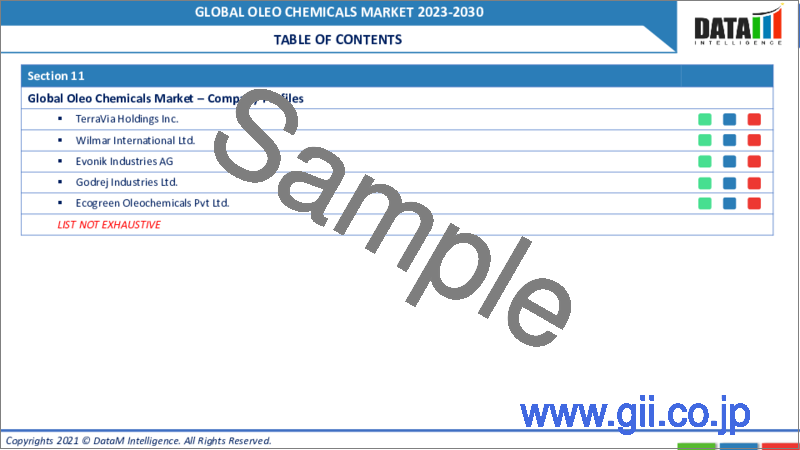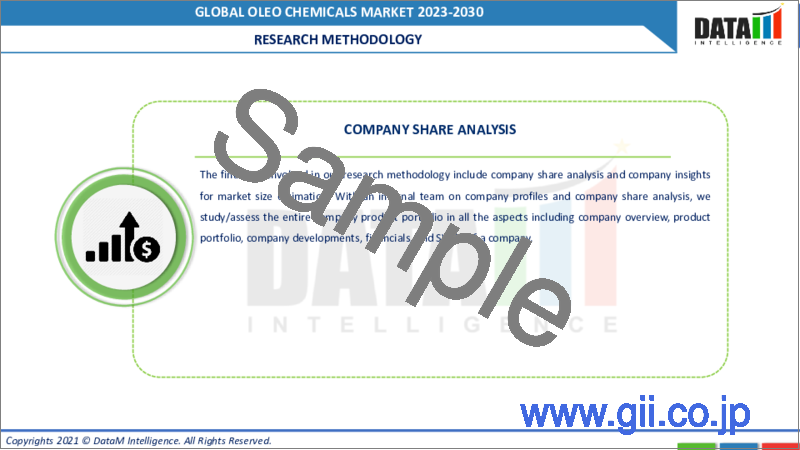|
|
市場調査レポート
商品コード
1022373
オレオケミカルの世界市場-2022-2029Global Oleo Chemicals Market - 2022-2029 |
||||||
|
● お客様のご希望に応じて、既存データの加工や未掲載情報(例:国別セグメント)の追加などの対応が可能です。 詳細はお問い合わせください。 |
|||||||
| オレオケミカルの世界市場-2022-2029 |
|
出版日: 2022年07月31日
発行: DataM Intelligence
ページ情報: 英文 210 Pages
納期: 約2営業日
|
- 全表示
- 概要
- 目次
市場力学
予測期間中、パーソナルケア製品や化粧品などの最終用途分野での特殊エステルの使用増加が市場の拡大を牽引すると予想されます。市場拡大の主な要因の1つは、石油化学製品への依存を減らすために、持続可能で生分解性のある製品への要望が高まっていることです。
消費者からの需要の高まり
オレオケミカル市場は、パーソナルケア、石鹸・洗剤、飲食品、その他の用途で使用される製品に対する消費者の需要の増加により、拡大すると予想されます。パーソナルケア、飲食品などのアイテムにおける消費者のグリセロールに対する嗜好の高まりにより、この物質が最も増加すると予想されます。さらに、主要な消費者は食品産業であると予想されます。世界の食品セクターは、加工食品の進歩と消費者の意識によって牽引されています。したがって、生分解性製品の需要の急増は、オレオケミカル市場の拡大を加速させると予想されます。
また、天然素材を原料とするオレオケミカルの需要が高まっていることも、オレオケミカル市場に影響を与える要因の一つです。世界のオレオケミカル市場は、オレオケミカルのような天然原料由来製品の使用を奨励する、製品の品質保持と健康への懸念への注力によって牽引されると考えられます。
バイオベースのオレオケミカルへの需要の高まり
植物や動物の脂肪のような天然原料は、油脂化学製品の主な生産源です。脂肪酸とその誘導体は、活性炭を使用して精製、脱色、脱臭が日常的に行われています。オレオケミカルは生分解性があり、毒性も低いため、環境にも優しい製品です。科学者や一般消費者は、これらの製品を天然、グリーン、有機、安全、再生可能、生分解性であるとみなしています。
科学者や消費者は、これらの品目を天然、グリーン、オーガニック、安全、再生可能、生分解性であるとみなしています。オレオケミカル業界は、再生不可能な資源が枯渇し、政府の環境法が強化されるにつれて拡大すると予想されます。その他の特典として、石油化学原料への依存度が低下し、従来の石油系製品に代わるオレオケミカルの用途が拡大することにより、オレオケミカルの市場は恩恵を受けると予想されます。
代替品の入手可能性
油脂化学品の市場拡大は、油脂化学品のサブセクターであるバイオディーゼルへの関心の高まりに影響を受けると予想されます。バイオディーゼルの順調な拡大により、オレオケミカルの需要が大幅に減少し、オレオケミカルの市場拡大が鈍化する可能性があります。また、植林や土地の確保に関連する環境問題も、オレオケミカル市場の全体的な経済性を損ねると予想されます。
COVID-19の影響分析
コロナウイルスの大流行は、あらゆる産業に何らかの形で影響を及ぼしています。しかし、オレオケミカルの市場には当てはまりません。油脂化学品の需要はおそらく増加します。マレーシア・パーム油協会(MPOC)によると、コロナウイルスの大流行によってオレオケミカルの需要が急増すると予測されており、市場はサプライチェーンに起こりうるショックに備えつつあります。洗浄剤、消毒剤、除菌剤への要求が高まったことが、需要増加の原因です。
しかし、油脂化学品のサプライチェーンは、需要の増加によって阻害されています。グリセリンについては、サプライチェーンが不安定になり、世界的に価格が上昇しました。世界の油脂化学品のサプライチェーンに大きな混乱をきたすのは、主にパーム油、ヤシ油、獣脂から生産される脂肪酸とアルコールの分野であると思われます。これは、量的な取引において、市場の関心が原料コストの下落を上回り始めたために起こることでしょう。
この調査レポートは、約53の市場データ表、44の図表、210ページにわたる情報を提供しています。
目次
第1章 オレオケミカルの世界市場の調査手法と範囲
- 調査手法
- 調査目的および調査範囲
第2章 オレオケミカルの世界市場-市場の定義と概要
第3章 オレオケミカルの世界市場- エグゼクティブサマリー
- タイプ別市場内訳
- アプリケーション別市場内訳
- 地域別市場内訳
第4章 オレオケミカルの世界市場-市場力学
- 市場影響因子
- 促進要因
- 消費者からの需要の高まり
- バイオベースのオレオケミカルへの需要の高まり
- 阻害要因
- 代替品の利用可能性
- ビジネスチャンス
- 影響分析
- 促進要因
第5章 オレオケミカルの世界市場- 産業分析
- ポーターのファイブフォース分析
- サプライチェーン分析
- 価格設定分析
- 規制分析
第6章 オレオケミカルの世界市場-COVID-19分析
- COVID-19の市場分析
- COVID-19市場参入前のシナリオ
- COVID-19の現在の市場シナリオ
- COVID-19の後、または将来のシナリオ
- COVID-19の中での価格ダイナミクス
- 需要と供給のスペクトル
- パンデミック時の市場に関連する政府の取り組み
- メーカーの戦略的な取り組み
- まとめ
第7章 オレオケミカルの世界市場- タイプ別
- 脂肪酸
- 脂肪アルコール
- メチルエステル
- グリセロール
第8章 オレオケミカルの世界市場-用途別
- 石鹸・洗剤
- パーソナルケア、化粧品
- 飲食品
- 医薬品
第9章 オレオケミカルの世界市場-地域別
- 北米
- 米国
- カナダ
- メキシコ
- 欧州
- ドイツ
- 英国
- フランス
- イタリア
- スペイン
- その他欧州
- 南米
- ブラジル
- アルゼンチン
- その他の南米地域
- アジア太平洋地域
- 中国
- インド
- 日本
- オーストラリア
- その他アジア太平洋地域
- 中東とアフリカ
第10章 オレオケミカルの世界市場- 競争情勢
- 競合シナリオ
- 市況分析・シェア分析
- M&A(合併・買収)分析
第11章 オレオケミカルの世界市場-企業プロファイル
- Emery Oleochemicals(M)Sdn Bhd
- 企業概要
- 製品ポートフォリオと内容
- 主なハイライト
- 財務概要
- SABIC
- BASF SE
- Cargill Inc.
- Akzo Nobel NV
- TerraVia Holdings Inc.
- Wilmar International Ltd.
- Evonik Industries AG
- Godrej Industries Ltd.
- Ecogreen Oleochemicals Pvt Ltd.
第12章 オレオケミカルの世界市場- 重要考察
第13章 オレオケミカルの世界市場-DataM
Market Overview
Oleochemicals market is estimated to reach at a high CAGR of 5.5 % during the forecast period (2022-2029).
Oleochemicals are chemical substances made from natural fats and oils used in various industries as raw materials or additional ingredients. Petrochemicals, which are made from petroleum, can be replaced with oleochemicals. In the late 1970s, manufacturers started transitioning from petrochemicals to oleochemicals due to the surge in crude oil costs and the low cost of plant-based lauric oils made from palm kernels.
Oleochemicals are used primarily in producing fatty acids, which are also created in numerous chemical and enzymatic processes. Chemical procedures like water-based hydrolysis, alcohol-based alcoholysis and hydrogenation, to mention a few, are used to create oleochemicals. Oleochemicals are safer than their synthetic chemical counterparts since they contain few or no carcinogens.
Market Dynamics
Throughout the forecast period, the market expansion is anticipated to be driven by an increase in the use of specialized esters in end-use sectors, including personal care products and cosmetics. One of the main factors propelling market expansion will continue to be the rising desire for sustainable and biodegradable products to lessen petrochemical dependence.
The growing demand from consumers
The oleochemicals market is anticipated to grow due to the increased consumer demand for products used in personal care, soaps and detergents, food and beverage and other applications. Due to consumers' rising preference for glycerol in items like personal care, food and beverages, the most increase is anticipated for this substance. Additionally, the key consumers are anticipated to be in the food industry. The worldwide food sector is being driven by advances in processed foods and consumer awareness; therefore, the surge in demand for biodegradable products is anticipated to accelerate the expansion of the oleochemicals market.
Another factor influencing the oleochemicals market is the growing demand for oleochemicals made from natural raw materials. The worldwide oleochemicals market will be driven by a focus on preserving product quality and health concerns that encourage using natural raw material-derived products like oleochemicals.
The rising demand for bio-based oleo chemicals
Natural raw materials like a plant or animal fat are the main source of oleochemical production. Fatty acids and their derivatives are routinely purified, decolored and deodorized using activated carbon. Oleochemicals are environmentally benign because they are biodegradable and have low toxicity. Scientists and the general public regard these products as natural, green, organic, secure, renewable and biodegradable.
Scientists and consumers consider these items natural, green, organic, secure, regenerative and biodegradable. The oleochemicals industry is anticipated to expand as non-renewable resources run out and government environmental laws tighten. Additionally, it is anticipated that the market for oleochemicals would benefit from the declining reliance on petrochemical feedstock and the growing applications of oleochemicals in place of conventional petroleum-based products.
Availability of substitutes
The market expansion for oleochemicals is anticipated to be impacted by the spike in interest in biodiesel, a subsector of oleochemicals. Oleochemical demand may significantly decline due to the steady expansion of biodiesel products, which might also slow the market growth of oleochemicals. Environmental issues associated with plantations and land availability are also anticipated to hurt the oleochemicals market's overall economics.
COVID-19 Impact Analysis
The coronavirus pandemic has impacted every industry in one way or another. But this is not true of the market for oleochemicals. Demand for oleochemicals is probably going to increase. The coronavirus pandemic is predicted to cause a sharp increase in oleochemical demand and markets are preparing for possible supply chain shocks, according to the Malaysian Palm Oil Council (MPOC). An increased requirement for cleaning supplies, disinfectants and sanitizers was the cause of the rise in demand.
However, the supply chain for oleochemicals has been hampered by the rise in demand. Prices on the worldwide glycerin market had risen as supply chain uncertainty increased. The following market sectors to experience significant disruption in the global oleochemicals chain would be fatty acids and alcohols, primarily produced from palm, coconut and tallow oils. It would happen as market interest started to outpace falling feedstock costs in the dealings for volumes.
Segment Analysis
By application, the oleo chemicals market is segmented into soaps and detergents, personal care and cosmetics, food & beverages and pharmaceutical.
Oleo Chemicals is a key element in soaps & detergents manufacturing
The oleo chemical market is dominated by the personal care and cosmetics segment due to the increased demand for cosmetics from organic and anti-aging products meant to maintain a person's physical and external look. Due to the enormous variety of personal care products and their applications globally, as well as the fact that the personal care and cosmetics business is one of the fastest expanding in the world, end consumers generally have more options to invest in the market.
The development of bio-specialty oleochemical products in the cosmetic industry is driven by the demand for goods for sensitive skin. Soon, it is projected that increasing consumer demand for natural and organic cosmetics, skincare and hair care products will drive the segment's growth. The use of organic material in various personal care products has received approval from human health and safety regulatory authorities, including USDA and FDA, which has fueled the business expansion.
Geographical Analysis
The huge end-use industries in Asia-Pacific
Over half of the world's output of oleochemicals is produced in Asia-Pacific, which is also the leading producer. Asia-Pacific does dominate not only regional shares but also growth rates. Due to superior economics and logistics, several enterprises that use oleochemicals have relocated to Asia-Pacific nations. As a result, Asia-Pacific as a consumer has stronger control over oleochemical manufacturing and distribution. Additionally, it is anticipated that easy access to feedstock and the rapid growth of important end-use industries will propel the market throughout the projection period. The main manufacturers of basic products for oleochemicals are Indonesia and Malaysia. In Asia-Pacific, China is the region that consumes the most oleochemicals.
According to the China Cleaning Industry Association (CCIA), these items are imported more than 2 million tonnes annually. Additionally, many international corporations, primarily from Malaysia and Singapore, have introduced several cutting-edge technologies and business practices. Because the leading nations are the primary producers of raw materials, palm oil and palm kernel oil are the main raw resources with significant regional consumption. Many domestic businesses were expanding their product lines and developing new ones in the interim. Since then, the oleochemicals business has experienced remarkable growth and will likely continue to do so for the foreseeable future.
Competitive Landscape
Due to the presence of both domestic and international businesses, the oleochemicals market is moderately competitive. The top companies use various growth methods, including product launches, acquisitions and collaborations, to boost their businesses and the global market for oleo chemicals.
The debut of Emery Oleo Chemicals' fatty acid ester product line, which went under the name Emery E, was announced for September 2020. This group of fatty esters can offer strong biodegradability, good color stability and low odor.
For instance, Emery Oleochemicals and Omya Inc. increased their distribution agreement in November 2019. The business is utilizing Omya's skills to offer technical assistance for Green Polymer Additives (GPA) products, such as release agents, antifogging, lubricants and specialty plasticizers, to Emery's U.S. customers.
Construction on a new PT Apical Kao Chemicals plant to generate fatty acids was finished in May 2019. Kao Corp and Apical Group Limited are partners in this business. The partnership improved production capacities and offered a steady supply.
Major global oleo chemicals market companies include Emery Oleochemicals (M) Sdn Bhd, SABIC, BASF SE, Cargill Inc., Akzo Nobel NV, TerraVia Holdings Inc., Wilmar International Ltd., Evonik Industries AG, Godrej Industries Ltd. and Ecogreen Oleochemicals Pvt Ltd.
Emery Oleochemicals (M) Sdn Bhd
Overview: Emery Oleochemicals' founder, Thomas Emery Sr., established a tallow and candle business in Cincinnati, Ohio, in 1840. Ten years later, The Emery Candle Company began selling dripless, whiter and more durable candles manufactured of stearic acid. Soon, sweetwater and elaine oil (oleic acid) were added to the growing product line (glycerine).
Elaine oil (oleic acid) and sweetwater were part of the company's expanding product line by 1872 and it was also engaged in fatty acid discoveries (glycerine). For additional information on our lengthy and inventive history, click here. Emery Oleochemicals is now, more than 180 years later, a name connected with manufacturing premium, natural chemicals frequently made from natural oils and fats.
Product Portfolio: The business offers fatty acids sourced from renewable raw materials, such as natural oils and fats. The company produces a wide variety of distilled, fractionated, polyunsaturated, oleic, stearic and food-grade fatty acids through its EMERY®, EMERSOL® and EDENOR® products suites. These acids are used, among other things, in food & beverage, cosmetics, personal care, pharmaceutical and metalworking applications.
Key Development: Emery Oleochemicals, a developer of natural-based specialty chemicals with a presence worldwide, just received the highest award from the Ohio Chemistry Technology Council for Excellence in Environmental Performance at its Cincinnati Plant in June 2021. (OCTC). The OCTC panel of judges chooses one program, known as the Eagle Award, that stands out as exceptional in scope, implementation, effect and sustainability.
Emery achieved important sustainability goals that the company set last year and for that, the Eagle Award was virtually given at the OCTC 33rd Annual Meeting in June 2021. To lessen the company's wastewater's impact on the nearby Metropolitan Sewer District of Greater Cincinnati's treatment plant, Emery Oleochemicals designed and executed a high-priority ISO 14001 Environmental Management Plan in 2020.
Why Purchase the Report?
- Visualize the composition of the oleo chemicals market segmentation by type, application and region, highlighting the critical commercial assets and players.
- Identify commercial opportunities in the oleo chemicals market by analyzing trends and co-development deals.
- Excel data sheet with thousands of oleo chemicals market-level 4/5 segmentation points.
- Pdf report with the most relevant analysis cogently put together after exhaustive qualitative interviews and in-depth market study.
- Product mapping in excel for the key product of all major market players
The global oleo chemicals market report would provide access to an approx. 53 market data table, 44 figures and 210 pages.
Target Audience 2022
- Oleo Chemicals Service Providers/ Buyers
- Industry Investors/Investment Bankers
- Education & Research Institutes
- Emerging Companies
- Oleo Chemicals Manufacturers
Table of Contents
1. Global Oleo Chemicals Market Methodology and Scope
- 1.1. Research Methodology
- 1.2. Research Objective and Scope of the Report
2. Global Oleo Chemicals Market - Market Definition and Overview
3. Global Oleo Chemicals Market - Executive Summary
- 3.1. Market Snippet By Type
- 3.2. Market Snippet By Application
- 3.3. Market Snippet By Region
4. Global Oleo Chemicals Market-Market Dynamics
- 4.1. Market Impacting Factors
- 4.1.1. Drivers
- 4.1.1.1. The growing demand from consumers
- 4.1.1.2. The rising demand for bio-based oleo chemicals
- 4.1.2. Restraints
- 4.1.2.1. Availability of substitutes
- 4.1.2.2. XX
- 4.1.3. Opportunity
- 4.1.3.1. XX
- 4.1.4. Impact Analysis
- 4.1.1. Drivers
5. Global Oleo Chemicals Market - Industry Analysis
- 5.1. Porter's Five Forces Analysis
- 5.2. Supply Chain Analysis
- 5.3. Pricing Analysis
- 5.4. Regulatory Analysis
6. Global Oleo Chemicals Market - COVID-19 Analysis
- 6.1. Analysis of COVID-19 on the Market
- 6.1.1. Before COVID-19 Market Scenario
- 6.1.2. Present COVID-19 Market Scenario
- 6.1.3. After COVID-19 or Future Scenario
- 6.2. Pricing Dynamics Amid COVID-19
- 6.3. Demand-Supply Spectrum
- 6.4. Government Initiatives Related to the Market During Pandemic
- 6.5. Manufacturers Strategic Initiatives
- 6.6. Conclusion
7. Global Oleo Chemicals Market - By Type
- 7.1. Introduction
- 7.1.1. Market Size Analysis and Y-o-Y Growth Analysis (%), By Type
- 7.1.2. Market Attractiveness Index, By Type
- 7.2. Fatty Acids*
- 7.2.1. Introduction
- 7.2.2. Market Size Analysis and Y-o-Y Growth Analysis (%)
- 7.3. Fatty Alcohols
- 7.4. Methyl Esters
- 7.5. Glycerol
8. Global Oleo Chemicals Market - By Application
- 8.1. Introduction
- 8.1.1. Market Size Analysis and Y-o-Y Growth Analysis (%), By Application
- 8.1.2. Market Attractiveness Index, By Application
- 8.2. Soaps and Detergents*
- 8.2.1. Introduction
- 8.2.2. Market Size Analysis and Y-o-Y Growth Analysis (%)
- 8.3. Personal Care and Cosmetics
- 8.4. Food & Beverages
- 8.5. Pharmaceutical
9. Global Oleo Chemicals Market - By Region
- 9.1. Introduction
- 9.2. Market Size Analysis and Y-o-Y Growth Analysis (%), By Region
- 9.3. Market Attractiveness Index, By Region
- 9.4. North America
- 9.4.1. Introduction
- 9.4.2. Key Region-Specific Dynamics
- 9.4.3. Market Size Analysis and Y-o-Y Growth Analysis (%), By Type
- 9.4.4. Market Size Analysis and Y-o-Y Growth Analysis (%), By Application
- 9.4.5. Market Size Analysis and Y-o-Y Growth Analysis (%), By Country
- 9.4.5.1. U.S.
- 9.4.5.2. Canada
- 9.4.5.3. Mexico
- 9.5. Europe
- 9.5.1. Introduction
- 9.5.2. Key Region-Specific Dynamics
- 9.5.3. Market Size Analysis and Y-o-Y Growth Analysis (%), By Type
- 9.5.4. Market Size Analysis and Y-o-Y Growth Analysis (%), By Application
- 9.5.5. Market Size Analysis and Y-o-Y Growth Analysis (%), By Country
- 9.5.5.1. Germany
- 9.5.5.2. UK
- 9.5.5.3. France
- 9.5.5.4. Italy
- 9.5.5.5. Spain
- 9.5.5.6. Rest of Europe
- 9.6. South America
- 9.6.1. Introduction
- 9.6.2. Key Region-Specific Dynamics
- 9.6.3. Market Size Analysis and Y-o-Y Growth Analysis (%), By Type
- 9.6.4. Market Size Analysis and Y-o-Y Growth Analysis (%), By Application
- 9.6.5. Market Size Analysis and Y-o-Y Growth Analysis (%), By Country
- 9.6.5.1. Brazil
- 9.6.5.2. Argentina
- 9.6.5.3. Rest of South America
- 9.7. Asia-Pacific
- 9.7.1. Introduction
- 9.7.2. Key Region-Specific Dynamics
- 9.7.3. Market Size Analysis and Y-o-Y Growth Analysis (%), By Type
- 9.7.4. Market Size Analysis and Y-o-Y Growth Analysis (%), By Application
- 9.7.5. Market Size Analysis and Y-o-Y Growth Analysis (%), By Country
- 9.7.5.1. China
- 9.7.5.2. India
- 9.7.5.3. Japan
- 9.7.5.4. Australia
- 9.7.5.5. Rest of Asia-Pacific
- 9.8. The Middle East and Africa
- 9.8.1. Introduction
- 9.8.2. Key Region-Specific Dynamics
- 9.8.3. Market Size Analysis and Y-o-Y Growth Analysis (%), By Type
- 9.8.4. Market Size Analysis and Y-o-Y Growth Analysis (%), By Application
10. Global Oleo Chemicals Market - Competitive Landscape
- 10.1. Competitive Scenario
- 10.2. Market Positioning/Share Analysis
- 10.3. Mergers and Acquisitions Analysis
11. Global Oleo Chemicals Market - Company Profiles
- 11.1. Emery Oleochemicals (M) Sdn Bhd
- 11.1.1. Company Overview
- 11.1.2. Product Portfolio and Description
- 11.1.3. Key Highlights
- 11.1.4. Financial Overview
- 11.2. SABIC
- 11.3. BASF SE
- 11.4. Cargill Inc.
- 11.5. Akzo Nobel NV
- 11.6. TerraVia Holdings Inc.
- 11.7. Wilmar International Ltd.
- 11.8. Evonik Industries AG
- 11.9. Godrej Industries Ltd.
- 11.10. Ecogreen Oleochemicals Pvt Ltd.
LIST NOT EXHAUSTIVE
12. Global Oleo Chemicals Market - Premium Insights
13. Global Oleo Chemicals Market - DataM
- 13.1. Appendix
- 13.2. About Us and Services
- 13.3. Contact Us




